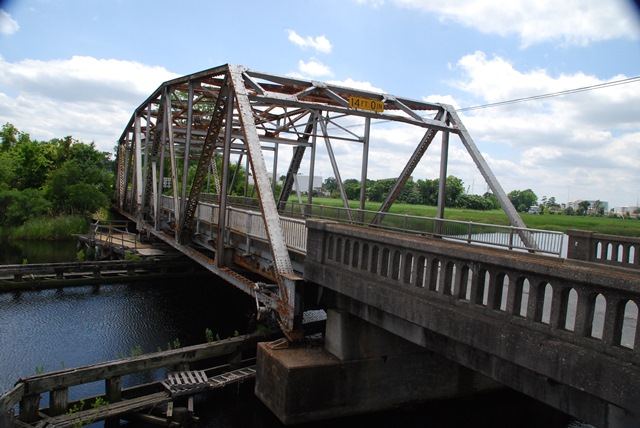We Recommend:
Bach Steel - Experts at historic truss bridge restoration.
Castle Hayne Road Bridge
Smith's Creek Bridge

Primary Photographer(s): Elaine Deutsch
Bridge Documented: July 2015
Wilmington: New Hanover County, North Carolina: United States
Metal 8 Panel Rivet-Connected Polygonal Warren Through Truss, Movable: Swing (Center Bearing Center Pier) and Approach Spans: Concrete T-Beam, Fixed
1930 By Builder/Contractor: T.A. Loving and Company of Goldsboro, North Carolina and Engineer/Design: North Carolina State Highway Commission
1982
172.0 Feet (52.4 Meters)
248.0 Feet (75.6 Meters)
27.2 Feet (8.29 Meters)
1 Main Span(s) and 2 Approach Span(s)
1290029

View Information About HSR Ratings
Bridge Documentation
Although it no longer operates for boats (as reported in 2008), this bridge remains a good example of a state-designed swing through truss bridge. The plaque on the bridge names the waterway Smith's Creek, but maps today show it as Smith Creek.
View Archived National Bridge Inventory Report - Has Additional Details and Evaluation
Information and Findings From North Carolina's Historic Bridge InventoryDiscussion of Bridge The State Highway Commission designed this through
truss, center-bearing, swing-span bridge in 1930 and contractor T.A.
Loving & Company of Goldsboro completed its construction in December of
the following year. Although largely supplanted by a modern highway to
the east, it continues to carry Castle Hayne Road (Old NC 133) over
Smith Creek into northern Wilmington and remains one of the earliest and
most complete examples of its type in the state. Its operator house and
controls have been replaced, but it retains its original gearing and
mechanical systems, and essentially operates as it did when originally
built. On notice of 24 hours, its swing span is put into motion. Bridge Considered Historic By Survey: Yes |
![]()
Photo Galleries and Videos: Castle Hayne Road Bridge
Bridge Photo-Documentation
Original / Full Size PhotosA collection of overview and detail photos. This gallery offers photos in the highest available resolution and file size in a touch-friendly popup viewer.
Alternatively, Browse Without Using Viewer
![]()
Bridge Photo-Documentation
Mobile Optimized PhotosA collection of overview and detail photos. This gallery features data-friendly, fast-loading photos in a touch-friendly popup viewer.
Alternatively, Browse Without Using Viewer
![]()
Maps and Links: Castle Hayne Road Bridge
Coordinates (Latitude, Longitude):
Search For Additional Bridge Listings:
Bridgehunter.com: View listed bridges within 0.5 miles (0.8 kilometers) of this bridge.
Bridgehunter.com: View listed bridges within 10 miles (16 kilometers) of this bridge.
Additional Maps:
Google Streetview (If Available)
GeoHack (Additional Links and Coordinates)
Apple Maps (Via DuckDuckGo Search)
Apple Maps (Apple devices only)
Android: Open Location In Your Map or GPS App
Flickr Gallery (Find Nearby Photos)
Wikimedia Commons (Find Nearby Photos)
Directions Via Sygic For Android
Directions Via Sygic For iOS and Android Dolphin Browser
USGS National Map (United States Only)
Historical USGS Topo Maps (United States Only)
Historic Aerials (United States Only)
CalTopo Maps (United States Only)

